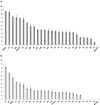Sequence diversity in the large subunit of RNA polymerase I contributes to Mefenoxam insensitivity in Phytophthora infestans
- PMID: 24521429
- PMCID: PMC6638662
- DOI: 10.1111/mpp.12124
Sequence diversity in the large subunit of RNA polymerase I contributes to Mefenoxam insensitivity in Phytophthora infestans
Abstract
Phenylamide fungicides have been widely used for the control of oomycete-incited plant diseases for over 30 years. Insensitivity to this chemical class of fungicide was recorded early in its usage history, but the precise protein(s) conditioning insensitivity has proven difficult to determine. To determine the genetic basis of insensitivity and to inform strategies for the cloning of the gene(s) responsible, genetic crosses were established between Mefenoxam sensitive and intermediate insensitive isolates of Phytophthora infestans, the potato late blight pathogen. F1 progeny showed the expected semi-dominant phenotypes for Mefenoxam insensitivity and suggested the involvement of multiple loci, complicating the positional cloning of the gene(s) conditioning insensitivity to Mefenoxam. Instead, a candidate gene strategy was used, based on previous observations that the primary effect of phenylamide compounds is to inhibit ribosomal RNA synthesis. The subunits of RNA polymerase I (RNApolI) were sequenced from sensitive and insensitive isolates and F1 progeny. Single nucleotide polymorphisms (SNPs) specific to insensitive field isolates were identified in the gene encoding the large subunit of RNApolI. In a survey of field isolates, SNP T1145A (Y382F) showed an 86% association with Mefenoxam insensitivity. Isolates not showing this association belonged predominantly to one P. infestans genotype. The transfer of the 'insensitive' allele of RPA190 to a sensitive isolate yielded transgenic lines that were insensitive to Mefenoxam. These results demonstrate that sequence variation in RPA190 contributes to insensitivity to Mefenoxam in P. infestans.
Keywords: Mefenoxam; Metalaxyl; Phytophthora infestans; RNA polymerase; fungicide; oomycete; phenylamide.
© 2014 BSPP AND JOHN WILEY & SONS LTD.
Figures



References
-
- Armstrong, M.R. , Whisson, S.C. , Pritchard, L. , Bos, J.I. , Venter, E. , Avrova, A.O. , Rehmany, A.P. , Böhme, U. , Brooks, K. , Cherevach, I. , Hamlin, N. , White, B. , Fraser, A. , Lord, A. , Quail, M.A. , Churcher, C. , Hall, N. , Berriman, M. , Huang, S. , Kamoun, S. , Beynon, J.L. and Birch, P.R.J. (2005) An ancestral oomycete locus contains late blight avirulence gene Avr3a, encoding a protein that is recognized in the host cytoplasm. Proc. Natl. Acad. Sci. USA, 102, 7766–7771. - PMC - PubMed
-
- Baxter, L. , Tripathy, S. , Ishaque, N. , Boot, N. , Cabral, A. , Kemen, E. , Thines, M. , Ah‐Fong, A. , Anderson, R. , Badejoko, W. , Bittner‐Eddy, P. , Boore, J.L. , Chibucos, M.C. , Coates, M. , Dehal, P. , Delehaunty, K. , Dong, S. , Downton, P. , Dumas, B. , Fabro, G. , Fronick, C. , Fuerstenberg, S.I. , Fulton, L. , Gaulin, E. , Govers, F. , Hughes, L. , Humphray, S. , Jiang, R.H. , Judelson, H. , Kamoun, S. , Kyung, K. , Meijer, H. , Minx, P. , Morris, P. , Nelson, J. , Phuntumart, V. , Qutob, D. , Rehmany, A. , Rougon‐Cardoso, A. , Ryden, P. , Torto‐Alalibo, T. , Studholme, D. , Wang, Y. , Win, J. , Wood, J. , Clifton, S.W. , Rogers, J. , Van den Ackerveken, G. , Jones, J.D. , McDowell, J.M. , Beynon, J. and Tyler, B. (2010) Signatures of adaptation to obligate biotrophy in the Hyaloperonospora arabidopsidis genome. Science, 330, 1549–1551. - PMC - PubMed
-
- Birch, P.R.J. , Bryan, G. , Fenton, B. , Gilroy, E.M. , Hein, I. , Jones, J.T. , Prashar, A. , Taylor, M.A. , Torrance, L.T. and Toth, I.K. (2012) Crops that feed the world 8: potato: are the trends of increased global production sustainable? Food Secur. 4, 477–508.
-
- Blum, M. , Boehler, M. , Randall, E. , Young, V. , Csukai, M. , Kraus, S. , Moulin, F. , Scalliet, G. , Avrova, A. , Whisson, S. and Fonne‐Pfister, R. (2010a) Mandipropamid targets the cellulose synthase‐like PiCesA3 to inhibit cell wall biosynthesis in the oomycete plant pathogen, Phytophthora infestans . Mol. Plant Pathol. 11, 227–243. - PMC - PubMed
Publication types
MeSH terms
Substances
Associated data
- Actions
- Actions
- Actions
Grants and funding
LinkOut - more resources
Full Text Sources
Other Literature Sources

